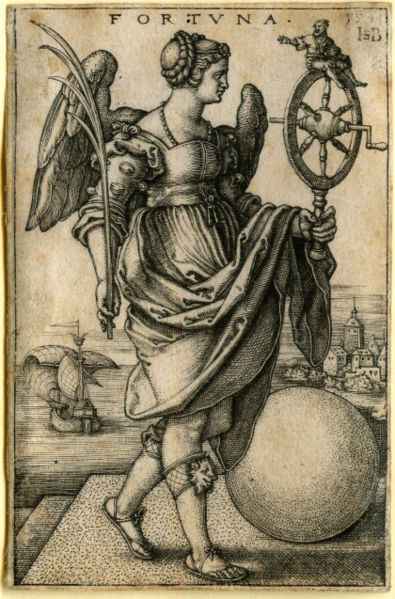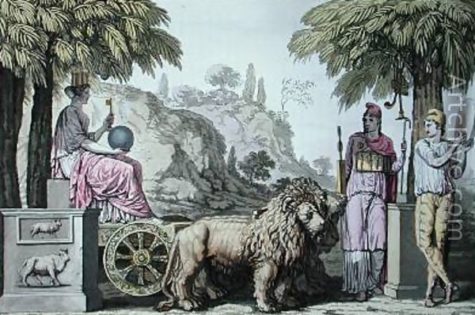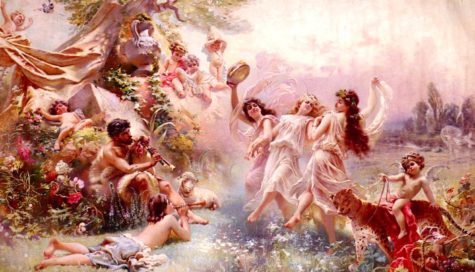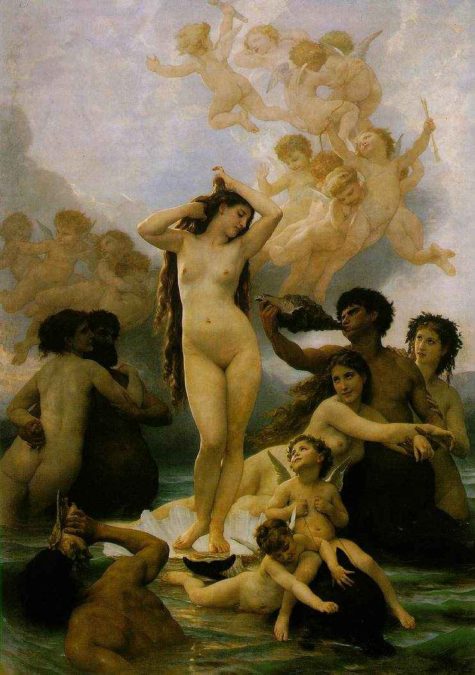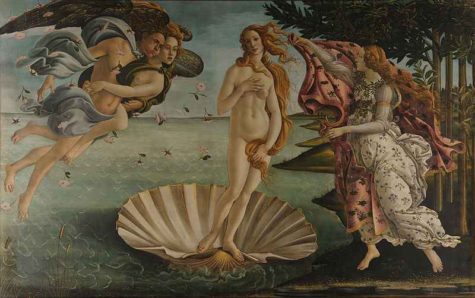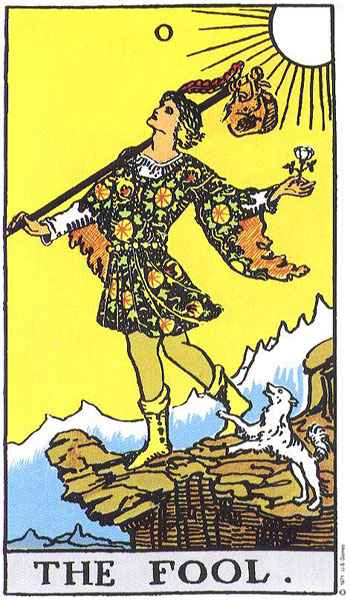April 5th. When the next Dawn shall have shone in the sky, and the stars have vanished, and the Moon shall have unyoked her snow white steeds, he who shall say, “On this day of old the temple of Public Fortune was dedicated on the hill of Quirinus”, will tell the truth.
~Ovid
April 5 is Lady Luck Day. As you can see from the above quote, it is dedicated to Fortuna, the Roman goddess of good fortune, and marks the day that her temple of Public Fortune was dedicated in Ancient Rome on the hill of Quirinus.
- Themes: Luck; Wealth; Abundance; Destiny; Success
- Symbols: Wheel; Cornucopia
About Fortuna:
Fortuna, whose name means ‘she who brings’, is the keeper of our destiny and the guiding power behind all fortunate events. She stands on top of Fortune’s wheel, steering us toward success and victory all year long.
To Do Today:
Who of us couldn’t us a little of Fortuna’s assistance with tax day on the horizon? For a little extra cash, dab your automobile, bike, or motorcycle wheels with almond oil or pineapple juice. Symbolically this invokes Fortuna’s help by keeping money “rolling” in! Also dab your steering wheel similarly – this way you can keep a “handle” on personal finances.
Romans traditionally asked Fortuna about their fate and difficult problems today, then received replies on slips of paper, often baked into small bread balls akin to a fortune cookie! This is fun for a gathering of people to try. Each person should write a word or short phrase on a piece of paper (all of which are equal in size). These get dropped into a bowl, and at the end of the day everyone can reach in to see what Fortuna has to say.
Wear colors that indicate to Fortuna what you need most (green for prosperity and luck, blue for victory, red for success, yellow for communication and creativity, and purple for spirituality and leadership qualities). Or, don lucky clothing and carry your lucky charms. Fortuna’s energy is already housed within them.
Found in: 365 Goddess
April gets its name from the goddess Aprilis, who is the Romans’ version of Aphrodite. Her name means “to open,” which is exactly what Aprilis does… she opens the path to playfulness and the way to personal enrichment.
We all know the rhyme “April showers bring May flowers.” So consider what energies you want Aprilis to sprinkle on you this month for personal flowering. Overall, any magical efforts aimed toward growth, love, pleasure, improvements, and developing one’s inner child will benefit from working this month.
Because the Christian holiday of Easter sometimes falls in this month, the Anglo-Saxons and Franks called it Easter Month; of course, the word Easter comes originally from the name of the Pagan goddess Eostre, deity of Spring, fertiilty, and new life. The Romans called this month Aprilis, a time of unfolding leaves and flowers.
April was the second month of the Roman calendar, before January and February were added by King Numa Pompilius about 700 BC. It became the fourth month of the calendar year (the year when twelve months are displayed in order) during the time of the decemvirs about 450 BC, when it also was given 29 days April is commonly associated with the season of spring in the Northern hemisphere and autumn in the Southern hemisphere.
Correspondences for April:
- Nature Spirits: Plant faeries
- Herbs: Basil, chives, dragons blood, geranium, thistle
- Colors: Crimson red, gold
- Flowers: Daisy, sweetpea
- Scents: Pine, bay, bergamot, patchouli
- Stones: Ruby, garnet, sard
- Trees: Pine, bay, hazel
- Animals: Bear, wolf
- Birds: Hawk, magpie
- Deities: Kali, Hathor, Anahita, Ceres, Ishtar, Venus, Bast
- Birth stone: Diamond
- Birth flower: Daisy or sweet pea
- Zodiac Signs: Aries (until April 19) and Taurus (April 20 onwards).
Power Flow:
Energy into creating and producing; return balance to the nerves; change; self confidence; self reliance; take advantage of opportunities; work on temper and emotional flare-ups and selfishness.
April Festivities:
The Megalesia of Cybele, who was also known as Magna Mater (Great Mother) in both Phyrgia and Rome, celebrated the arrival of this goddess in Rome. In 204 BCE, Rome was in the midst of a great war with Hannibal. Things were going very badly for the Roman legions. Finally, the Romans sent a delegation to the Oracle at Delphi for an interpretation of their sacred Sibylline Books. This passage said that foreing invaders could only be driven away when the Mother of Mount Ida was transferred from Pessinus to Rome.
The oracle sent the delegation to the king of Pergamum in Asia Minor, where they were told that a black meteroite embodying the spirit of Cybele was. Pine trees from Mt. Ida, sacred to the goddess, were made into a ship, and the stone was transported from one sanctuary to another until it reached Rome. In about a year, Hannibal left Italy forever.
The Japanese Flower Festival has now become a celebration of Buddha’s birth. In the older celebration, however, the people gathered wildflowers for the family shrine. Those in the Shinto faith placed wooden markers on the graves and said prayers.
The Roman festival of Cerealia celebrated the return of Proserpina to the Earth goddess Ceres. Our word “cereal” comes from the name Ceres. It was the time of planting grain. Ceres was the Roman equivalent to the Greek goddess Demeter.The festival of Cerealia was held for seven days from mid-to-late April, but exact dates are uncertain.
Feriae Latinae was also held in April, with the date varying. Other ancient Roman observances include Veneralia, Fordicidia, Parilia, Vinalia Urbana, Robigalia, and Serapia.
The Egyptians called their land Khemennu, or Land of the Moon. Plutarch wrote that they believed the Moon to be the Mother of the Universe. Although the goddess Bast was primarily considered to be a deity of the gentle Sun, she was also connected with the Moon.
Floralia was held April 27 during the Republican era, or April 28 on the Julian calendar, and lasted until May 3. However, these dates do not correspond to the modern Gregorian calendar. The Floralia is still celebrated in many Central and Eastern European countries. It is a time to honor the goddess of flowers. People dress in gaily decorated costumes and wear flowers in their hair. Secretly delivering baskets of flowers on May Day is a remnant of this old festival.
During this month was also the Incan Ayrihua or Camay Inca Raymi, the Festival of the Inca.
April Weather Lore
It is said that if early April is foggy,
rain in June will make lanes boggy.
April weather:
rain and sunshine, both together.
April showers bring May flowers.
A dry April
Not the farmer’s will.
April wet
Is what he would get.
“If it rains on Easter Sunday,
it will rain on the next seven Sundays.”
More April Lore:
St George’s day is the twenty-third of the month; and St Mark’s Eve, with its superstition that the ghosts of those who are doomed to die within the year will be seen to pass into the church, falls on the twenty-fourth.
In China the symbolic ploughing of the earth by the emperor and princes of the blood took place in their third month, which frequently corresponds to April. In Finnish April is huhtikuu, meaning slash-and-burn moon, when gymnosperms for beat and burn clearing of farmland were felled.
In Slovene, the most established traditional name is mali traven, meaning the month when plants start growing.
The month Aprilis had 30 days; Numa Pompilius made it 29 days long; finally Julius Caesar’s calendar reform made it again 30 days long, which was not changed in the calendar revision of Augustus Caesar in 8 BC.
The Lyrids meteor shower appears on April 16-April 26 each year, with the peak generally occurring on April 22. Eta Aquariids meteor shower also appears in April. It is visible from about April 21 to about May 20 each year with peak activity on or around May 6. The Pi Puppids appear on April 23, but only in years around the parent comet’s perihelion date. The Virginids also shower at various dates in April.
The theme for April
The theme for April is momentum. When something has momentum it takes more of an effort to change its course, and less of an effort to move it in the direction it is already going. This is a tricky month as momentum will take hold in whatever direction you happen to be putting your focus and energy.
For example, if you are in a bad mood, that mood is in danger of gathering momentum. If you are focused on a creative project of your choosing, it will also gather momentum. It is very important that you are focused on the things you want in your life at this time for they are the ones that will gather momentum.
This is a highly creative and productive time. The challenge will be to stay directed and to have the discipline to move yourself out of situations and away from negativity that you would rather not be gathering momentum around. This will take discernment, the use of good boundaries and a commitment to some truth telling about what serves you and what does not.
If you find yourself in a downward spiral where everything seems to be falling apart in a big way, you may need to look at the truth of allowing something you have been holding onto to dissolve and leave your life. You may finally have the momentum to move yourself out of a situation that is not healthy or serving. On the other hand, a creative project that is aligned with spirit may have just been waiting for such a time to take off.
From:
- Moon Magick
- Lena Stevens, The Power Path
- Various other sources
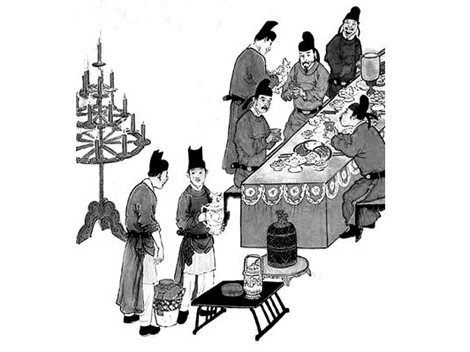 The Cold Food Festival or Hanshi Festival is a traditional Chinese holiday celebrated for three consecutive days starting the day before the Qingming Festival in the Chinese Calendar, which falls on the 105th day after dongzhi (April 5 by the Gregorian calendar, except in leap years). It is celebrated in China as well as the nearby nations of Korea and Vietnam. At this time of year, the sky becomes clearer and buds sprout in the field. Farmers sow various seeds and supply water to their rice paddies.
The Cold Food Festival or Hanshi Festival is a traditional Chinese holiday celebrated for three consecutive days starting the day before the Qingming Festival in the Chinese Calendar, which falls on the 105th day after dongzhi (April 5 by the Gregorian calendar, except in leap years). It is celebrated in China as well as the nearby nations of Korea and Vietnam. At this time of year, the sky becomes clearer and buds sprout in the field. Farmers sow various seeds and supply water to their rice paddies.
The Cold Food Festival started from the ancient tradition of setting fire by rubbing wood pieces together and the tradition of lighting new fires. Due to the change of seasons and the change in the type of wood available, the ancient practice was to change the type of fire-starter-wood used from season to season. Fire is lighted anew upon the start of each season. Before the new fire is officially started no one is allowed to light a fire. This was an important event during that time.
The traditionally practiced activities during the Cold Food Festival includes the visitation of ancestral tombs, cock-fighting, playing on swings, beating out blankets (to freshen them), tug-of-war, etc. The practice of visiting ancestral tombs is especially ancient.
In China ancestral worship used to be practiced during the time of the Cold Food Festival. It was later moved to coincide with the Qingming Festival. However in Korea, where the festival is called Hansik , the tradition of ancestral worship during the Cold Food Festival still remains.
In the modern version of Hansik, people welcome the warm weather thawing the frozen lands. On this day, rites to worship ancestors are observed early in the morning, and the family visits their ancestors’ tombs to tidy up.
Falling on the 105th day after the winter solstice (April 5 by the Gregorian calendar, except in leap years). At this time of year, the sky becomes clearer and buds sprout in the field. Farmers sow various seeds and supply water to their rice paddies. The custom of eating cold food on this day is believed to originate from a Chinese legend (see Tomb Sweeping Day), but recently this custom has disappeared.
Since this day coincides with Arbor Day, public cemeteries are crowded with visitors planting trees around the tombs of their ancestors.
In Vietnam, where it is called Tết Hàn Thực, the Cold Food Festival is celebrated by Vietnamese people in the northern part of the country on the third day of the third lunar month, but only marginally. People cook glutinous rice balls (see recipe and more info) called bánh trôi on that day but the holiday’s origins are largely forgotten, and the fire taboo is also largely ignored.
Source: Wikipedia
The Megalisia was a Phrygian festival in honor of Cybele, the Magna Mater. This was a festival with games celebrated at Rome in the month of April and in honor of the great mother of the gods. Following the advice of the Sibylline oracle on how to end the Punic wars, the meteorite which represented Cybele was brought from Phrygia to Rome in 204 BCE where it was installed in the Temple of victory on April 4th. The day of its arrival was solemnized with a magnificent procession, lectisternia, and games, and great numbers of people carried presents to the goddess at the Capitol.
The following harvest was great and the war ended the next year.
The regular celebration of the Megalesia, however, did not begin until about a dozen years later, when the temple which had been vowed and ordered to be built in 203 B.C., was completed and dedicated by M. Iunius Brutus.
The Romans began the celebrations with a parade, in which an image of the Goddess, Cybele, was carried through the streets in a chariot drawn by lions, her animals. The castrated priests who served her danced alongside, playing timbrels and cymbals and gashing themselves. Lucretius says “with bronze and silver they strew all the paths of her journey … and snow rose-blossoms over her.”Rome, commemorating the arrival of the goddess to her Roman Temple.”
The festival lasted for six days, beginning on the 4th of April. The season of this festival, like that of the whole month in which it took place, was full of general rejoicings and feasting. It was customary for the wealthy Romans on this occasion to invite one another mutually to their repasts, and the extravagant habits and the good living during these festive days were probably carried to a very high degree. For that reason, a senatusconsultum was issued in 161 B. C., prescribing that no one should go beyond a certain extent of expenditure.
The games which were held at the Megalesia were purely scenic, and not circenses. They were at first held on the Palatine in front of the temple of the goddess, but afterwards also in the theaters.
The first ludi scenici at Rome were, according to Valerius Antias, introduced at the Megalesia, either in 193 or 191 b.c. The day which was especially set apart for the performance of scenic plays was the third of the festival.
Slaves were not permitted to be present at the games, and the magistrates appeared dressed in a purple toga and praetexta, whence the proverb, purpura Megalensis. The games were under the superintendence of the Curule Aediles, and we know that four of the extant plays of Terence were performed at the Megalesia. Cicero, probably contrasting the games of the Megalesia with the more rude and barbarous games and exhibitions of the circus, calls them maxime casti, solemnes, religiosi.
Source: Nova Roma and Smith, Dictionary of Greek and Roman Antiquities
Note:
The book, 365 Goddess, describes this festival as a Roman Festival celebrating the accuracy of the Sibylline oracles, who predicted the way for the Roman victory in the Punic Wars. Her suggestions for celebrating this ancient festival is as follows:
- Themes: Divination, Protection, Victory, Children, Birth, Communication.
- Symbols: The written word, Divination tools, Fertility symbols.
- Rulers: The Carmenae.
The Carmenae is a group of goddesses who correspond to the Muses of Greek tradition; they know our past, see what’s in store in the future, foretell children’s fates, and teach us the effective use of “letters” (the alphabet), the arts, and how to tell fortunes. They also oversee midwives.
Romans traditionally honored the goddesses today with music and song, so put on some magical tunes! The Carmenae will saturate the music and uplift your spirit.
Ask the Carmenae to help you write personalized invocations or spells today. Put pen to pad and let these goddesses inspire sacred words suited to your path and needs. Keep these in a magick journal for future use.
The Roman oracles often drew lots to determine a querent’s answer. If you have a question weighing heavily on your heart today, follow this custom and take out some variegated beans. Hold them. Concentrate on the question, then pick out one bean. A black one means “no”; white means “yes.” Red means that anger is driving action, brown means things are muddled, and green indicates growth potential. If you don’t have the beans, colored buttons or beads are a suitable alternative.
Qingming Festival (also known as Pure Brightness Festival or Tomb-sweeping Day), falls on either April 4th or 5th of the Gregorian calendar. The Chinese respect for filial piety and careful attention to funeral rites is visibly manifested in the custom of ancestor worship.
Since ancient times, a day has been designated for sweeping the tomb and honoring one’s ancestors. Though different in each family, these rites are usually performed on the first few days prior to or following Ching Ming, one of the traditional solar divisions falling in early April, when the frost retreats and spring returns bringing renewal to all living things.
When visiting the tomb, people usually bring the dead person’s favourite food and wine, and paper resembling money . This is in the hope that the deceased are not lacking food and money. After burning the paper money, tidying up the tomb, and putting willow branches around the gates and doors of the tomb to ward off evil spirits, people will eat the food and fruit before returning to their homes.
The folklore behind the story is as follows:
It is said that the Qingming Festival was originally held to commemorate a loyal man living in the Spring and Autumn Period (770 – 476 BC), named Jie Zitui. Jie cut a piece of meat from his own leg in order to save his hungry lord who was forced to go into exile when the crown was in jeopardy. The lord came back to his position nineteen years later, and forgot Jie Zitui but later felt ashamed and decided to reward him. However, Jie had blocked himself up in a mountain with his mother. In order to find Jie, the lord ordered that the mountain should be set on fire. Later Jie was found dead with his mother. In order to commemorate Jie, the lord ordered that the day Jie died was Hanshi (Cold Food) Festival – the day that only cold food could be eaten.
The second year, when the lord went to the mountain to sacrifice to Jie, he found willows revived, so he gave instructions that the day after Hanshi Festival was to be Qingming Festival. Later, the two festivals were combined as one.
Traditional Customs
Qingming Festival is a time of many different activities, among which the main ones are tomb sweeping, taking a spring outing, and flying kites. Some other lost customs like wearing willow branches on the head and riding on swings have added infinite joy in past days. The festival is a combination of sadness and happiness.
Cleaning the tomb and paying respect to the dead person with offerings are the two important parts of remembering the past relatives. Weeds around the tomb are cleared away and fresh soil is added to show care of the dead.
Today, with cremation taking over from burying, the custom has been extremely simplified in cities. Only flowers are presented to the dead relatives and revolutionary martyrs. No matter how respect is shown, good prayers for the deceased are expressed.
All in all, the Qingming Festival is an occasion of unique characteristics, integrating sorrowful tears to the dead with the continuous laughter from the spring outing.
From: Travel China Guide
The Veneralia (April 1) was the Ancient Roman festival of Venus Verticordia (“Changer of hearts”), the goddess of love and beauty. The worship of the goddess Fortuna Virilis (“Bold fortune”) was also part of this festival.
In Rome, jewelry was ritually removed from the statue of the goddess, her image was then taken from her temple to the men’s baths, where it was undressed and washed in warm water by her female attendants, then garlanded with myrtle.
Similarly, women bathed themselves in the public baths wearing wreaths of flowers and myrtle on their heads. It was generally a day for women to seek divine help in their relations with men. Men also asked Venus Verticordia for her help in affairs of the heart, sex, betrothal and marriage.
Here’s a nice ritual for the Day of Venus:
- Color: Sea green, golden, and pink
- Element: Water
- Altar: Upon cloth of sea green, golden and pink, set many shells, flowers, beautiful ornaments, pink candles, hearts, doves, incense of rose and violets, and a great chalice of white wine.
- Offerings: Hearts and flowers. Giving a gift of love to someone.
- Daily Meal: Seafood. Angel hair pasta. Sweet breads, cakes, and desserts.
Invocation to Venus
Hail, Lady of the Morning Star!
You who rose form the sea foam,
Born of the impersonal severed phallus of the sky
Immersed in the impersonal womb of the sea,
You who rode to shore on a shell of pearl
And whose powers no one can resist
Save the virgin goddesses,
You who bring the glow of gold
Into the lives of all whom you touch,
Lady, we revere you as the avatar
Of the love between equals
Who look each other in the eye,
The attraction and pursuit
Between every particle in the universe.
Hail, Lady of the Evening Star!
You who rule the night
With its darker passions,
You who tempt the wistful heart,
You whose hands reach out
To all the world and more,
Lady, we revere you as a force of nature
Far greater than merely the human heart,
For you are the force that binds together
All that dances with another of its kind
In the endless dance of creation.
(The wine is passed around, and poured as a libation to Venus. Each takes a flower and wears it in honor of Venus.)
Chant:
Venus Veritas
Amor Amor
Source: Wikipedia and Pagan Book of Hours
The first of April, some do say,
Is set apart for All Fools’ Day.
But why the people call it so,
Nor I, nor they themselves do know.
But on this day are people sent
On purpose for pure merriment.
— Poor Robin’s Almanac (1790)
The practice of playing tricks on April 1st dates back to 15th century France. Before that time, New Year’s Day was March 25, with a full week of partying and exchanging gifts until April 1. In 1582, the Gregorian calendar moved New Year’s Day to January 1. This was so unpopular that people began sending officials on “fool’s errands” in retaliation. The term “All Fools,” was probably meant as a deliberate stab at All Saints (November 1) and All Souls (November 2) Day.
Another source reports that when the dates changed, many peasants paid surprise visits to their neighbors on April 1 to trick them into thinking it was still the start of the New Year. Gradually the custom spread around the world, and people look forward to this day as an opportunity to play tricks on their friends and colleagues.
April Fools Superstitions:
- It is considered bad luck to attempt to trick someone after noon on April 1.
- Children born on April 1 are believed to be lucky, except when they gamble.
- If a man gets married on April 1, his wife will dominate him.
- It is considered bad luck to become annoyed when someone plays a practical joke on you on April Fools Day.
- If a young lady plays a practical joke on an eligible man on April Fool’s Day, it is a sign that they will marry.
Weather folklore states:
“If it thunders on All Fools Day,
It brings good crops of corn and hay.”
Around the world:
“All Fools’ Day” is practiced in many parts of the world with practical jokes, hoaxes, and sending people on a fool’s errand.
In Scotland, April Fools Day lasts 48 hours. Day two is know as Taily Day, and pranks involving the posterior are played. The victim’s practical joke is referred to as “hunting the gowk”; the gowk is an extinct cuckoo bird. When used here it mean foolish person.
Dinna laugh, dinna smile.
Hunt the gowk another mile.
In France, victims of the prank is the “poisson d’Avril” or “fish of April.” The fish in April are newly hatched and easily caught. French children enjoy taping a picture of a fish on their friends back and yelling out “Poisson dAvril!” when it is found.
In the United States, pranks are played on just about everybody. Pranks range from the standard “Your shoe is untied”, to some very creative and elaborate ideas. The only “rule” is that no one should be harmed. Corporations, newspapers, and television stations will also play practical jokes on the public on April Fools Day.
Magickal Applications:
Pranks and fun aside, this is a good day to consider the nature of the Fool and his associations with The Craft.
Fools have long been considered to be blessed by the Gods; indeed it used to be thought lucky to meet one on the way to work. The Fool is the first card in the Tarot where he represents the start of the magical journey and the step into the unknown. He is also still represented in decks of ordinary playing cards by the Joker or Jester.
The Fool is also linked with the Jester in his role of storyteller, or Bard, who traveled around taking news from place to place. Not only that but with connotations of riotous frivolity he is associated with fertility festivals and may appear as the Teaser in midsummer Rites.
His staff or wand with bells relates back to the sticks which were used to beat fertility into the population at the festivals of Pan. Hence he is linked with the trickster Gods Puck and Loki.
To gain a greater understanding of the Fool take this card from a Tarot deck and place one green and one red candle on either side. Light them and focus on the image before you. As you meditate on it, consider the journey of the Fool:
- Where is he going?
- Who will he meet?
From: The Real Witches’ Year, Encyclopedia of Superstitions, and various other sources.
Mothering Sunday has been celebrated on the fourth Sunday of Lent since the 16th century. In Bristol, Mothering Sunday was commemorated with Mothering Buns as well as cakes.
A Mothering Bun is a circular, slightly enriched, bread bun with white sugar icing strewn with hundreds-and-thousands. These small, fairly plain yeast rolls were also topped with the much-appreciated caraway or aniseed comfits (candies) that also flavored bath buns and seed cake.
From The Verse-Book of a Homely Woman:
Then down to Farmer Westacott’s, there’s doings fine and grand,
Because young Jake is coming home from sea, you understand.
Put into port but yesternight, and when he steps ashore,
‘Tis coming home the laddie is, to Somerset once more.
And so her’s baking spicy cakes, and stirring raisins in,
To welcome of her only chick, who’s coming Mothering.
Here’s a recipe:
A specialty of Bristol, these are made by local bakers the day before Mothering Sunday. Traditionally, on this day only, the Lent fast was relaxed. The buns used to be decorated with caraway or aniseed; today, hundreds and thousands are used.
Ingredients for the buns:
- 500g strong white bread flour
- 1 tsp salt
- 50g caster sugar
- 7g sachet instant yeast
- 50g unsalted butter, diced and softened
- 300ml water
Ingredients for the icing:
- 200g icing sugar
- 2–3 tbsp water
Instructions:
Put the flour in a large bowl. Add the salt and sugar on one side, the yeast on the other. Add the butter and three-quarters of the water, then turn the mixture round with the fingers of one hand. Add the remaining water a little at a time, mixing until you have taken in all the flour and the dough is soft and slightly sticky; you might not need all the water.
Oil the work surface to stop the dough sticking. Turn out the dough and knead for 5 mins, or until smooth and no longer sticky. Lightly oil the bowl, return the dough to it and cover with cling film. Leave to rise for at least an hour, until doubled in size. Line 2 baking trays
with baking parchment.
Scrape the dough out of the bowl onto a lightly floured surface and fold it inwards repeatedly until all the air has been knocked out and the dough is smooth. Divide into 12 pieces.
Roll each piece into a ball by placing it into a cage formed by your hand on the work surface and moving your hand in a circular motion, rotating the ball rapidly.
Put the balls of dough on the prepared baking trays, spacing them slightly apart. (They should just touch each other when they have risen.) Place each tray in a clean plastic bag and leave to prove for about 40 mins, until the rolls have doubled in size. Heat the oven to 220C/Fan 200/425F.
Bake for 10–12 mins, until the rolls are golden and sound hollow when tapped underneath. Transfer to a wire rack to cool.
For the icing, mix the icing sugar with enough water to give a thick but pour-able consistency. Dip each roll into the icing and then into the hundreds and thousands. Makes 12 buns.
Sources: Foods of England and Simple Things
Mothering Sunday is a holiday celebrated by Catholic and Protestant Christians in some parts of Europe. It falls on the fourth Sunday in Lent, exactly three weeks before Easter.
The other names attributed to the fourth Sunday in Lent include:
- Refreshment Sunday
- Pudding Pie Sunday (in Surrey, England)
- Mid-Lent Sunday
- Simnel Sunday
- Rose Sunday
Simnel Sunday is named after the practice of baking simnel cakes to celebrate the reuniting of families during the austerity of Lent. (Here is a recipe: Simnel Cake.) Because there is traditionally a relaxation of Lenten vows on this particular Sunday in celebration of the fellowship of family and church, the name Refreshment Sunday is sometimes used, although rarely today.
Simnel cake is a traditional confection associated with both Mothering Sunday and Easter. Around 1600, when the celebration was only held in England and Scotland, a different kind of pastry was preferred. In England, “Mothering Buns” or “Mothering Sunday Buns” were made to celebrate. These sweet buns are topped with pink or white icing and the multi-colored sprinkles known as “hundreds and thousands” in the UK. (Here’s a recipe: Mothering Buns). They are not widely made or served today in the UK but in Australia they are a bakery staple, not related to any particular celebration. In Northern England and Scotland some preferred “Carlings”, pancakes made of steeped peas fried in butter.
It is sometimes said that Mothering Sunday was once observed as a day on which people would visit their “mother” church. During the 16th century, people returned to their mother church, the main church or cathedral of the area, for a service to be held on Laetare Sunday. This was either the church where they were baptized, or the local parish church, or more often the nearest cathedral.
Anyone who did this was commonly said to have gone “a-mothering”, although whether this term preceded the observance of Mothering Sunday is unclear. In later times, Mothering Sunday became a day when domestic servants were given a day off to visit their mother church, usually with their own mothers and other family members. The children would pick wild flowers along the way to place in the church or give to their mothers. Eventually, the religious tradition evolved into the Mothering Sunday secular tradition of giving gifts to mothers.
It was often the only time that whole families could gather together, since on other days they were prevented by conflicting working hours, and servants were not given free days on other occasions.
Whatever its origins, it is now an occasion for honoring the mothers of children and giving them presents. It is increasingly being called Mothers’ Day, although that has always been a secular event quite different from the original Mothering Sunday. In the UK and Ireland, Mothering Sunday is celebrated in the same way as Mothers’ Day is celebrated elsewhere.
By the 1920’s the custom of keeping Mothering Sunday had tended to lapse in Ireland and in continental Europe. In 1914, inspired by Anna Jarvis’s efforts in the United States, Constance Penswick-Smith created the Mothering Sunday Movement, and in 1921 she wrote a book asking for the revival of the festival.
Its wide scale revival was through the influence of American and Canadian soldiers serving abroad during World War II; the traditions of Mothering Sunday, still practiced by the Church of England and Church of Ireland were merged with the newly imported traditions and celebrated in the wider Catholic and secular society. UK-based merchants saw the commercial opportunity in the holiday and relentlessly promoted it in the UK; by the 1950’s, it was celebrated across all the UK.
People from Ireland and the UK started celebrating Mothers’ Day on the same day that Mothering Sunday was celebrated, the fourth Sunday in Lent. The two celebrations have now been mixed up, and many people think that they are the same thing.
Mothering Sunday remains in the calendar of some Canadian Anglican churches, particularly those with strong English connections.
Found at: Wikipedia
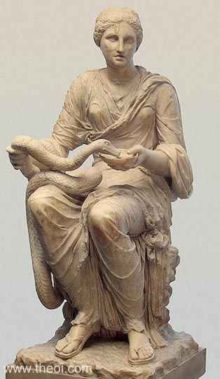 March 30 is the Festival of Salus, the Roman goddess of public safety, health and welfare.
March 30 is the Festival of Salus, the Roman goddess of public safety, health and welfare.
Salus was a minor goddess, the daughter of Aesculapius, the god of healing, whose staff, with a snake coiled round it, is symbolic of the practice of medicine. Their Greek equivalents were Aklepios and Hygeia. Her role in the pantheon was to feed and care for her father’s sacred snakes and act as his assistant. She was worshiped as being responsible for the welfare, not just of individuals, but of the people as a whole. Her name in Greek and Roman comes down to us in such words as ‘hygiene,’ ‘salve’ and ‘salubrious,’ and even ‘salute’ and ‘safe.’
In works of art, of which a considerable number has come down to our time, she was represented as a virgin dressed in a long robe, with the expression of mildness and kindness, and either alone or grouped with her father and sisters, and either sitting or standing, and leaning on her father. Her ordinary attribute is a serpent, which she is feeding from a cup.
To invoke the healing power of Salus (Hygeia) either of these two invocations can be used, or you can create an invocation of your own.
“O much desired, prolific, general queen. Hear me, life-bearing Hygeia, of beauteous mien, mother of all; by thee diseases dire, of bliss destructive, from our life retire; and every house is flourishing and fair, if with rejoicing aspect thou art there. Each daidal art thy vigorous force inspires, and all the world thy helping hand desires. Hades, life’s bane, alone resists thy will, and ever hates thy all-preserving skill. O fertile queen, from thee for ever flows to mortal life from agony repose; and men without thy all-sustaining ease find nothing useful, nothing formed to please. Without thy aid, not Hades’ self can thrive, nor man to much afflicted age arrive; for thou alone, of countenance serene, dost govern all things, universal queen. Assist thy mystics with propitious mind, and far avert disease of every kind.”
~ Orphic Hymn 68
“Hygeia, most revered of the blessed ones among mortals, may I dwell with you for what is left of my life, and may you graciously keep company with me: for any joy in wealth or in children or in a king’s godlike rule over men or in the desires which we hunt with the hidden nets of Aphrodite, any other delight or respite from toils that has been revealed by the gods to men, with you, blessed Hygeia, it flourishes and shines in the converse of the Kharites; and without you no man is happy.”
~from the Ariphron
